Many people don’t know why marketing strategy is important, what goes into a marketing strategy or where to start.
Marketing strategy underpins your business direction, helps you to achieve your objectives and gives focus to your marketing plan.
Shooting Star’s ultimate guide to marketing strategy will help you to create your own strategy or refine your existing strategy – you can download the guide or use the links below to jump to the sections you need.
Marketing strategy underpins your business direction, helps you to achieve your objectives and gives focus to your marketing plan.
What is marketing?
Marketing covers a huge area and plays a vital role in contributing to the success of any business.
Marketing and business development are firmly intertwined, and one shouldn’t be considered without the other when working on business growth.
There are many misconceptions about marketing and many moving parts that need to be considered when mapping out your strategy, plan and tactical implementation.
This guide will dive deep into the world of marketing, giving you the clarity and tools you will need for your business.
The definition of marketing
The Oxford English Dictionary definition of marketing:
“The action or business of promoting and selling products or services, including market research and advertising.”
The Chartered Institute of Marketing definition of marketing:
“Marketing is the management process responsible for identifying, anticipating and satisfying customer requirements profitably.”
In a nutshell, marketing aims to achieve specific goals, like building awareness and driving sales, through the art of promoting a brand, product, service or idea to a target audience.
What is marketing in business?
Marketing is the communicative function that sits in the middle of an organisation and its audiences. An organisation will have a range of target audiences, including existing customers, potential customers, employees, shareholders etc – whoever your business intends to communicate with.
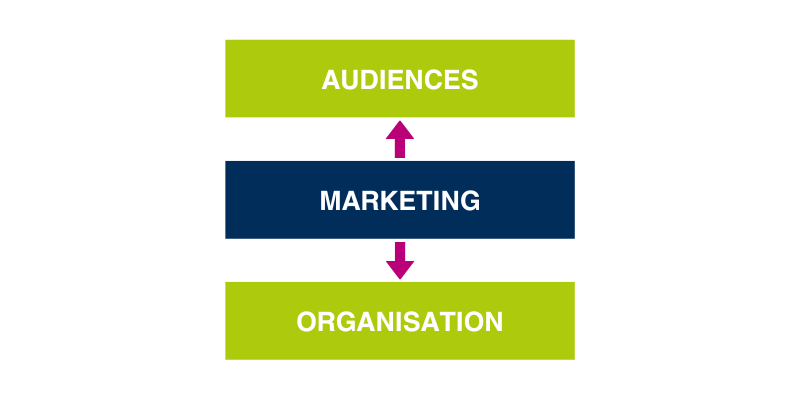
Marketing is what you say, how you say it and when you say it. It explains why customers should engage with you and what value you can add to them – so make it sparkle! Marketing is incorporated in the journey of a business and/or product from start to finish.
However, it isn’t just about promotion – this only forms a small part of a marketing strategy. There are a wide range of strategies and tactics that a business can implement to achieve its goals.
In business, marketing is used for market research to understand consumer behaviour, to differentiate from competitors, to identify market opportunities, to develop relationships, to craft persuasive communication, to generate leads and to drive revenue. Ultimately, marketing needs to deliver value.
The difference between marketing, communications, public relations, branding, advertising and digital.
Many people cannot distinguish the difference between marketing, advertising, PR, branding, communications and digital, and use these terms interchangeably. In reality, marketing encompasses all of these elements, but let’s define each term below:
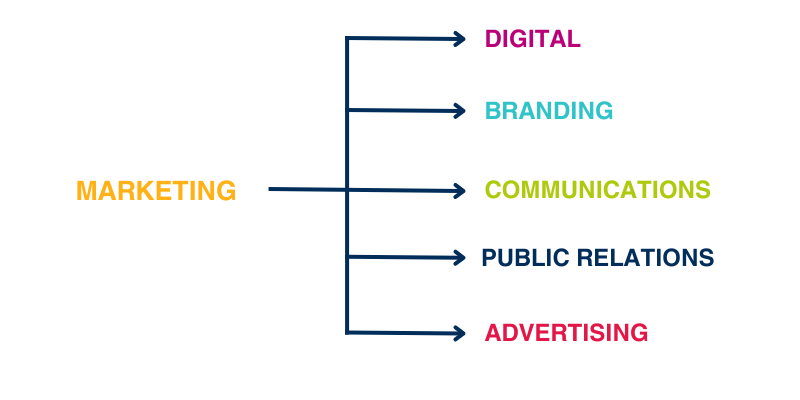
- Marketing – marketing is all about identifying and satisfying the needs of customers and building relationships through promotion and communication.
- Communications – messages and channels used to communicate with a target audience.
- Public relations – building trust, developing a positive image and managing reputation.
- Branding – creating a recognisable business identity in the minds of consumers.
- Advertising – a tactic using paid methods to sell products or services.
- Digital – a tactic using digital methods to communicate. Download Shooting Star’s handy guide on ‘What is Digital Marketing’.
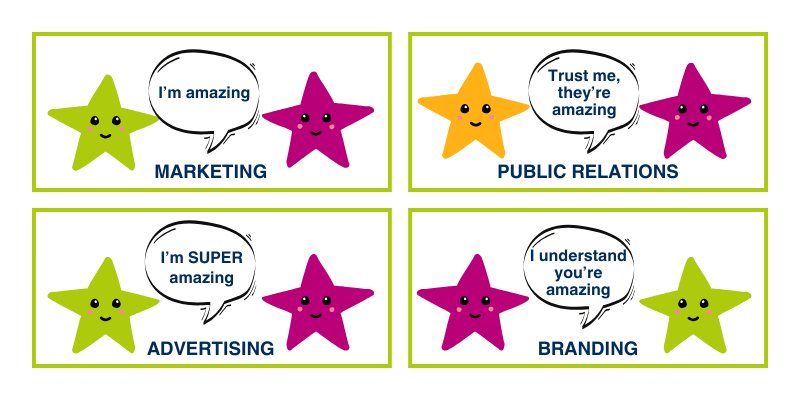
Marketing and sales are very closely aligned and often overlap but are two different entities. Marketing communicates with an audience and promotes products and services that businesses sell. Once marketing has reeled in the leads, the sales department closes the deal through negotiation.
Often, we find that in-house marketing managers are also tasked with other responsibilities, from sales to advertising and even human resources! Switching and wearing too many hats can often put pressure on time and resources – so make sure you prioritise what’s important or get extra support when you need it.
The history of marketing
Marketing has been around for centuries and dates back to ancient civilisation when traders promoted their goods and services – bartering using engaging and convincing communications for other goods or services they needed.
Marketing evolved significantly over time into four distinct eras:
- Production – pre 1920s – the industrial revolution generated mass produced goods. Brands thrived because there were limited alternatives. Wars disrupted the supply chain and rationing was prevalent. Traditional marketing methods like print and billboards were utilised.
- Sales – 1920s to 1950s – customer demand bred more modern marketing techniques. The marketing mix (product, price, place, promotion) was developed, competition increased, price became important, and companies developed customer-centric approaches to meet demand. Radio and TV technologies emerged.
- Marketing – from 1950s – marketing boomed! Hard sell became less effective, the customer was considered king and companies worked harder to get to know their audience. Digital and mobile technologies started to emerge.
- Relationship – from 1990s – the digital revolution brought the arrival of the internet and new platforms to reach customers, eg social media, search engines, email marketing, ecommerce etc allowing companies to focus on collecting quality data and getting to know their customers personally, thereby meeting their customers’ needs and delivering value.
Today, a marketer’s focus continues to be centred on building relationships and delivering value.
The marketing rule of seven states that a potential customer must see your message at least seven times before taking action
The importance of marketing
In today’s fast-paced world we are overwhelmed with choice. There are hundreds of platforms to communicate on, oodles of content to entertain us, millions of brands shouting to try and meet our needs. It is noisy and competitive.
Good marketing is essential for businesses and organisations of all sizes to stand out and effectively communicate to and sell to their target audience.
Marketing helps businesses to:
- Build brand awareness and equity
- Understand audiences (build and maintain relationships)
- Expand into new markets (new products, new locations)
- Drive sales (promote products / services through creative campaigns and engaging comms)
- Differentiate from competitors
- Innovate and adapt to change
- Plan ahead and allocate resources
The marketing rule of seven
The marketing rule of seven was developed by the movie industry in the 1930s and states that a potential customer must see your message at least seven times before taking action, eg going to see the movie.
However, in the 1930s marketing channels were limited to a handful of traditional options, eg radio, TV, print. Today, we have countless marketing channels at our fingertips, so the marketing rule of seven could now be the marketing rule of 30!
It is important to remember that ‘taking action’ doesn’t necessarily mean a sale – it could be entering a competition, filling out a web form or signing up to a seminar. In today’s competitive landscape, it is clear that messages must be present on multiple channels to achieve the desired objective.
A marketing strategy is what you are offering, a marketing plan is how you plan to deliver your offering
The difference between a marketing strategy and a marketing plan
There is a distinct difference between a marketing strategy and a marketing plan, and it is important that a business has both
A marketing strategy is what you are offering – it is the long-term, high-level approach that maps out your objectives, defines your brand, details your budget, and identifies your position, eg audience, competitors, current market, areas for improvement etc.
A marketing plan is how you plan to deliver your offering – it is a six to 12-month actionable document which maps out how you will achieve your goals, eg which messages will be pushed to which audiences on which marketing channels. It allows you to focus on the day-to-day running of your marketing while also planning in promotional campaigns designed to achieve specific objectives.
A strategy without a plan of action is redundant; a plan of action without strategy lacks focus and consistency.
How to create a marketing strategy
As businesses change over time, a marketing strategy should be flexible and be revised every six to 12 months.
There are several factors that should be included. The fundamental elements below help form the foundation of your strategy and provide the brickwork for your plan.
Marketing strategy – core brand and business elements
- Mission statement – what is the core purpose of your business? How does your company achieve its purpose? This statement shouldn’t be more than 100 words and is action orientated. It should be clear and concise and should feature three things: your target audience, your product/service and your USP.
Mission statement example:
“Create groundbreaking sports innovations, make our products sustainably, build a creative and diverse global team, and make a positive impact in communities where we live and work” – Nike.
- Vision statement – your vision statement is what your business aspires to achieve and what wider impact it hopes to make. It is inspirational and shouldn’t be more than 35 words.
Vision statement example:
“Bring inspiration and innovation to every athlete* in the world.
*If you have a body, you are an athlete” – Nike.
- Values – choose three to five values that reflect what your organisation stands for. These are the guiding principles that will help shape your company culture.
Company values example:
- Do the right thing.
- Be on the offense always.
- Serve athletes*
- Create the future of sport.
- Win as a team.
* If you have a body, you are an athlete – Nike.
- Unique Selling Point (USP) – define what sets your business apart from competitors, eg is your customer service outstanding? Do you prioritise quality over all else? Do you provide the most affordable solution?
- Brand personality – what human characteristics define your brand? As outlined above, marketing is all about relationships, connecting with your audience and delivering value, so humanising your brand is important. Brand personality helps differentiate you from competitors, captures attention and helps tell a story.
How to define your brand personality – there are two main methods for helping a business to define its brand personality, and a third method that combines the two. It is best to pick a handful of adjectives that describe your brand.
Brand personality example:
Adventurous, strong, genuine, exciting, inspirational – Nike.
- Tone of voice – outline how you speak to your customers. The tone of voice is guided by your brand personality and company values.
The four dimensions of tone of voice are a good starting point for developing your company’s language and allow a visual representation between formal and casual, serious and funny, respectful and irreverent, matter-of-fact and enthusiastic.
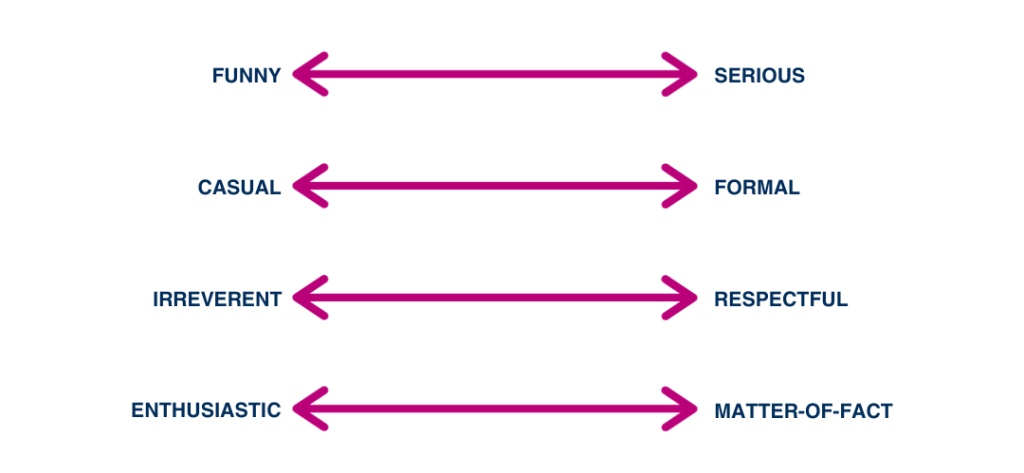
Remember that tone of voice is often adapted to suit methods of communication, eg a news article will be written very differently to an Instagram post.
- Brand style – this is the visual identity of your brand, eg logo, colour palette, typography, image style etc. All these elements must be defined and consistent in all communications.
Defining key messages
Every company should have clearly defined key messages to ensure all communication is targeted and consistent. Compelling key messages resonate with your audience and align with your brand.
They are not taglines, and they are not memorised word for word, but they do act as guidance when crafting your communication on various channels and when shaping your brand in the mind of consumers.
When crafting your key messages, revisit your vision and mission statements, your values, your brand personality, style and tone of voice – everything that makes up your brand.
Use the core information to create three to five main key messages which will form part of your strategy. You should also have key messages per target audience and key messages per campaign.
Setting goals, objectives and KPIs
Clearly defined marketing goals, objectives and KPIs help to focus and prioritise your efforts. A marketing strategy might set out several broad goals.
Common marketing goals:
- Increase brand awareness
- Improve brand loyalty / engagement (increase customer value)
- Generate high-quality leads
- Grow and maintain thought leadership – position yourself as experts, educate
- Engage employees – talent recruitment, empower existing employees
- Increase sales
- Acquire new customers
Common marketing objectives that help to achieve goals include:
- Develop a new website / increase website traffic
- Gain more social media followers.
- Grow an email list.
- Launch a new product to market
- Opening in a new location
- Improve conversion rates.
- Get more website or social media engagement.
- Drive more click-throughs on paid ads
- Creating a focused recruitment drive
Ensure marketing goals and objectives are SMART:
- Specific – state what you will do using action-based language
- Measurable – evaluate using metrics or data
- Achievable – set realistic expectations that are achievable within your scope
- Relevant – improves the business
- Time-bound – state when you will aim to achieve this objective by
SMART objectives act as a baseline for setting Key Performance Indicators (KPIs) – KPIs set specific measurable metrics that track your progress towards achieving your SMART goals and objectives.
Example KPI: Double our website traffic over the next 12 months by publishing or updating five high-quality, targeted blog posts per month.
Example SMART goal: Increase sales by 10% in the next quarter.
KPI to achieving that goal: Aim to generate five new leads per month.
Example SMART objective: Run a new eight-week marketing campaign.
KPI to achieving that objective: Increase website traffic by 10% in each month.
Target Market & Target Audience
Target Market
The target market is a large group of people that you want to target with shared characteristics:
- Demographics – age, relationship status, income, education
- Geographics – post code, city, county, country, climate, urban/rural
- Psychographics – personality, attitudes, beliefs, hobbies, lifestyles
- Behaviour – spending habits, brand loyalty / usage, customer satisfaction
The target audience is a smaller segment of the market you are looking to target.
Example: McDonald’s target market is mainly lower to middle class consumers interested in a convenient, low-cost meal. McDonald’s target audience groups might include families, students, commuters, early-morning contractors, travelling salespeople etc.
Target Audience
Segmenting your target market into audience groups allows you to be more targeted with your marketing messages and marketing campaigns. For example, McDonald’s will use different marketing campaigns and messages to target students and early-morning contractors.
How to identify your target audience – research! Explore the data of your existing customers and employees, send out surveys, analyse the competition and conduct wider market research to understand how your product / service solves a problem for your target customer.
Buyer Persona
It can be helpful to create a fictitious character of your ideal customer based on data and research. It can also help to create a negative buyer persona outlining who you don’t want as a customer.
Market Research
SWOT Analysis
Conducting a SWOT (Strengths, Weaknesses, Opportunities, Threats) analysis helps your business to identify areas for improvement and opportunities, builds on strengths and mitigates risks. It also helps to focus marketing efforts.
- Strengths – what you do well, your USP, internal resources like tools and staff, tangible assets like property and stock
- Weaknesses – areas that your company lacks, areas where your competitors win, limitations on resources, clarity on your core business offering
- Opportunities – underserved markets for specific products, positive media coverage, fewer competitors in certain areas
- Threats – Competitors, negative media coverage, changing attitudes to your company
PESTLE Analysis
The PESTLE (Political, Economic, Social, Technological, Legal, Environmental) analysis looks at the broader external factors that might affect a business.
- Political – this could be at a local, regional or nationwide level and can include governmental leadership changes, changes in law / policies or trade restrictions
- Economic – factors influencing the economy such as inflation rates, interest rates, economic growth, property prices, cost-of-living crisis. It could differ between geographic areas
- Social – including changing social behaviours like the rise of communicating on social media, wellbeing, culture and demographics like population growth rates
- Technological – these factors have changed processes and quality in our day-to-day lives dramatically, such as smart phones and AI
- Legal – laws that impact a business, eg privacy laws, consumer laws etc
- Environmental – sustainability, climate changes, weather, natural disasters.
The Marketing Funnel & Customer Journey Maps
The marketing funnel and customer journey maps are great tools for understanding how your target audience interacts with your business, from the first touchpoint through to becoming a customer. It forms part of your research before you create a marketing plan.
As mentioned previously, the marketing rule of seven predicts that a potential customer needs to see your message at least seven times before acting. Using a customer journey map and marketing funnel allows you to identify the gaps in your communication.
Using these two tools should produce similar results. Ultimately, using the customer journey map to collect the touchpoints and feeding it into your marketing funnel will ensure you are targeting leads effectively and help you create a user-friendly experience.
The Marketing Funnel
The marketing funnel is a linear process which details the stages that a customer will go through from the first touchpoint with your company through to conversion.
When creating a marketing plan or devising a marketing campaign you need to make sure you are hitting all areas of the marketing funnel with targeted messages on a variety of marketing channels. It is why an integrated approach – across traditional and digital – is much more effective.
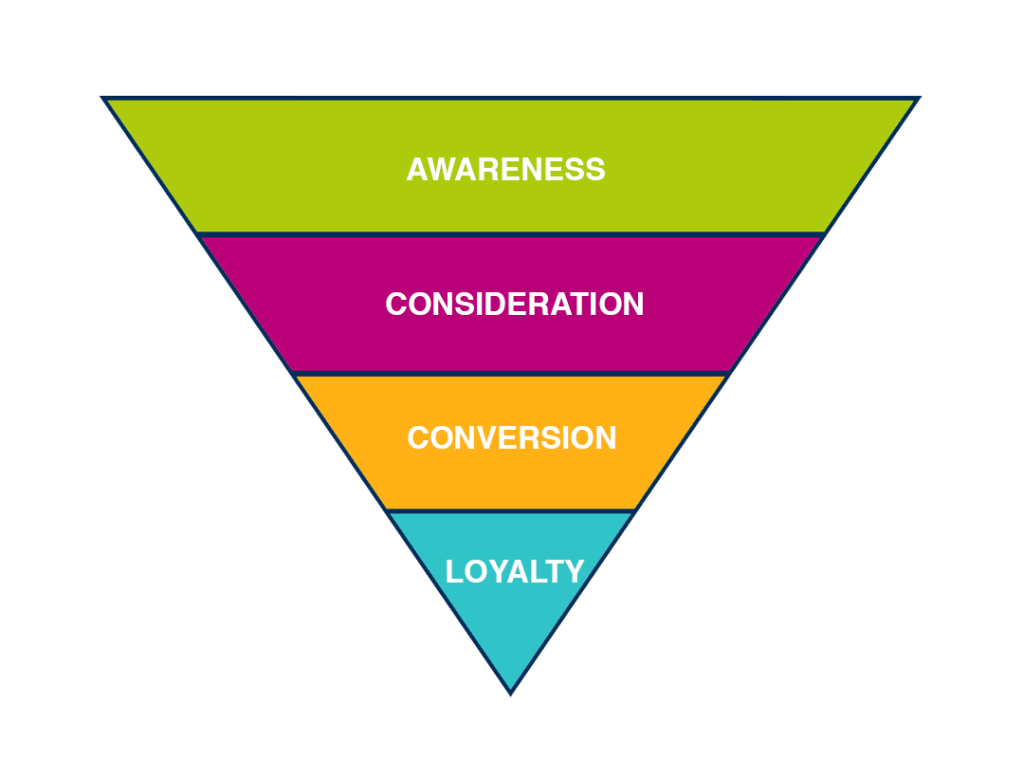
The marketing funnel stages:
- Awareness – the opportunity to create a strong first impression through advertising, PR, social media, website, blogs, videos, CSR activity
- Consideration – engage with your audience through targeted and re-targeted advertising, email signup and newsletter marketing, signing up to taster sessions, case studies, guides, webinars, reviews
- Conversion – encourage action, eg taster sessions, pitching and proposals, quoting, onboarding process, mapping out a plan for the company, providing support and resources
- Loyalty – nurture relationships, eg refer a friend, CSR activity, testimonials and case studies, surveys and feedback, random acts of kindness
Customer Journey
A customer journey is less linear and is depicted as a more winding process. It still starts from the first interaction with a brand and ends at the purchase. It allows your company to map out all the potential touchpoints a lead encounters before making a purchase.
Many people will return to an earlier touchpoint as they evaluate the product / service they are considering, hence the wandering journey rather than a linear one. It can be tricky to map but useful for identifying opportunities and strengths.
Competitor Analysis
Competitor analysis can be labour intensive but worth it! It can allow you to identify opportunities to strengthen your own offering and help to generate your own ideas for future campaigns, drawing on what your competitors did and did not do well.
Identify your direct and indirect competitors and research their products, pricing, perks, shipping, target audience, social content, marketing promotion, keywords, sales tactics etc. It can also help to do a SWOT analysis on your competitors.
It could be that you have different SEO, PPC or social media competitors from your traditionally known competitors – these are companies that are performing well on specific channels and competing for attention alongside your company. You can find these companies using your chosen SEO tool, like Semrush, and on social media via Meta Business Suite.
Big Marketing Ideas
This is not essential to include in your marketing strategy, but it can be helpful to review previous marketing campaigns you have run and analyse their results, as well as outlining ideas for future marketing campaigns to give context to the campaigns that you will include in your tactical marketing plan.
Marketing Mix
The marketing mix is another marketing strategy tool that is best used to bridge the gap between your overall strategy and your marketing plan. It defines the tactics that will be used to implement your marketing strategy; for example it could be used to help provide structure when implementing your ‘big marketing ideas’ and campaign plans.
The seven Ps of the marketing mix:
- Product – take time to develop the particulars of your product or service. It doesn’t have to be a new product; it could be an update or new feature – but it always must provide value to the customer. Define it through quality, branding, features, customer service, use, availability etc.
- Promotion – the way the company communicates through PR and marketing. Consider using a combination of Paid, Earned, Shared and Owned (PESO) media and always ensure messaging is consistent and attracts attention.
- Price – a product/service is only worth what customers are willing to pay for it. This doesn’t mean cheaper if your positioning is more premium or offers more added value, but this must be reflected in every experience your customer has with your brand, eg website, packaging, promotions. Existing customers are less sensitive about price – which is why it is important to look after them!
- Place – where a customer experiences your product, whether physically or online. In today’s digital world, your website is your shop window so ensure this platform is as effective as it can be, ie user friendly, SEO optimised etc. If your product is delivered via a third party, you want the customer to experience the same service you uphold.
- People – who delivers the products/services and are there skills gaps? Do your people operate under your company values? Many customers cannot separate the product or service from the staff member who delivers it – your employees have a profound effect on customer satisfaction and are your greatest ambassadors, often supporting the company through word of mouth. Ensure you invest in training, internal communications, company culture and staff wellbeing to keep your people as your greatest advocates.
- Process – understand the customer journey from start to finish and map out every touchpoint so these can be improved upon. Remember it can take up to seven brand interactions until someone converts, so are your customers reassured at every step that you are a reputable company?
- Physical evidence – provide physical evidence to minimise the risk of a new purchase to new customers, eg reviews, case studies, endorsements, clean office / home page, well shot images and videos showcasing your company, excellent customer service and staff who are enthusiastic.
Marketing investment
It is tempting to cut budgets when it comes to marketing, and it often can be the first cost to go. However, especially in today’s noisy world, brands need to step up to compete.
As a general rule of thumb, newer companies should invest 12 to 20% of gross revenue in marketing, whereas established companies should invest 6 to 12%. Allocate your budget wisely, considering various marketing channels and tactics.
Paid advertising, both traditional and digital adverts, should form part of your strategy, especially when operating in a B2B sphere. The B2B marketing funnel is more complex than the standard B2C customer journey and paid social helps to reduce the gap between awareness and enquiry.
The market is extremely saturated with more and more businesses competing for attention. Investing in paid advertising keeps a brand front of mind, is an awareness driver and can be good for lead generation (especially on social media).
Translating a marketing strategy into a marketing plan
Once you have nailed your strategy, it’s time to look at your tactical implementation – this takes the form of a plan that resembles a calendar.
The marketing plan outlines the day-to-day marketing activities as well as your big marketing ideas for campaigns to achieve specific objectives. Check out our team’s favourite Valentine’s Day marketing campaigns.
The marketing plan will include different marketing tactics, like digital marketing, and different marketing channels, like social media, that you will use to communicate with your target audience.
Shooting Star is putting together a handy guide that will walk you through how to create and implement a marketing plan – so stay tuned! Sign up to our newsletter to be the first to receive our marketing plan guide.
Modern marketing trends include customer experience above all else, video marketing and artificial intelligence – embrace the change!
Modern marketing trends
Marketing is constantly evolving, especially with new digital advancements that develop every year.
Here are some important trends you can utilise for your business:
Customer experience and personalisation
In today’s modern world, marketing is all about cultivating relationships; you must meet the customers’ needs and add value. Personalising marketing as per your customers’ preferences is the best way to grow your business.
Digital marketing
Most people are online and using digital tools to research, socialise, shop, work etc, so it is important that your business can cut through the noise. Make sure your website is SEO-optimised and reflective of your brand style, harness the power of social media, send personalised email marketing and utilise digital advertising to stand out.
Content marketing
This is an excellent example of meeting customer needs and adding value. It can take time to create quality content like guides, whitepapers, blogs, templates and so on. If you place these resources behind a gated web form, then you can also collect valuable information which allows you to personalise future content.
Video marketing
Video content is proven to be infinitely more engaging than any other media type. Using video content to attract attention and entertain should form a key part of your strategy.
Data privacy
Google announced that it will stop supporting third-party cookies on its Chrome browser by the end of 2023. As we move toward a cookieless world it will be harder for marketers to collect data and understand which marketing channels lead to conversion. This is why an integrated approach is still the strongest strategy.
Influencer marketing
The power of social media is not to be underestimated. People are now using social platforms not only to socialise but also to shop and digest news, so it’s an ideal platform to connect with your target audience. The greatest form of persuasion is word of mouth, so partnering with influencers who have already established loyal followers is worth it.
Voice search
This technology has come on in leaps and bounds. Many people have Amazon’s Alexa, Apple’s Siri and Google Assistant in their homes and on their phones. People are using voice search to search the web, so it is time to start optimising your website for this functionality.
Artificial Intelligence
There are now hundreds of tools available to marketers which has led to a noticeable increase in productivity and improving workflows, leaving more time to focus on developing relationships, adding value and working on your wider strategy.
Getting started with your marketing strategy
Don’t put the cart before the horse! It is important to invest time in your strategy to help inform your marketing plan.
That doesn’t mean you need to stop your tactical implementation while you map out your strategy. Time is limited, we understand, so try to allocate a little time each week to refine your strategy until you are happy with it and tweak your plan to accommodate.
A good place to start is to use the headings in this guide for your own marketing strategy and fill in the information you have – this will help you to identify any gaps or areas that require improvement.
If you still need a guiding star, the Shooting Star team can help. Get in touch to find out how we can help grow your business.
Article created on November 8, 2023










